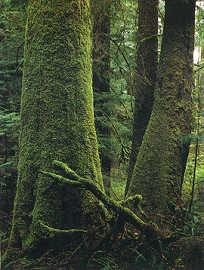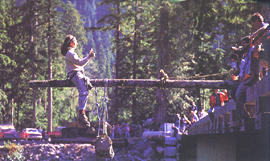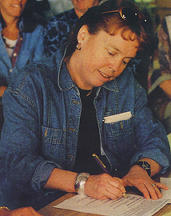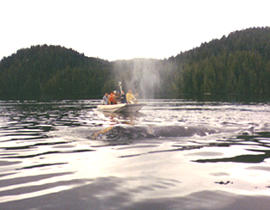By Bob
By Bob
The Clayoquot Women

It would take a book to do justice to the 20-year campaign to save the ancient forest of Clayoquot Sound. But this is a pretty good shot at capturing the highlights in 3500 words. It was published in slightly different form in Homemakers' Magazine in September '99.
The Weigh West Resort and Marina in Tofino, B.C., isn't exactly the Hyatt, but then there is the view: looking out across Clayoquot Sound, it is easy to see why so many people have fought so long over these mountains, forests and fjords. A salmon jumps, a seal pops up, a pod of orcas pass by. The nearby islands are dotted with eagles' nests. Behind them loom the dark green slopes of Meares Island.

On June 16, 1999, the forest was hidden in mist, but the people gathered in the Weigh West's conference room knew it was there. God or Nature may have created the Clayoquot wilderness, but these people had kept it that way, sometimes at great personal cost. Though you would not know it from the way they were dressed - only Chief Larry Baird wore a tie, and it sported a bald eagle and the words "Harley Davidson" - this was an august gathering. There were a dozen Nuu-chah-nulth chiefs and elders and half-a-dozen heads of major environmental groups. Two vice-presidents from the forest giant MacMillan Bloedel had helicoptered in.
A year before, this meeting was about as likely as peace in the Middle East. As it was, the air was charged. Maureen, Adriane, Valerie, Tzeporah and Linda wouldn't have missed it for the world.
On this afternoon in June, they were signing the deal that could, at long last, save the ancient Clayoquot rainforest. When it was her turn to sign, Western Canada Wilderness Committee director Adriane Carr burst into tears.
It was Carr - and Maureen Fraser, Valerie Langer, Tzeporah Berman and Linda Coady - who did it. Not alone, certainly; there were others who played key roles in the Clayoquot campaign, men among them. But the 20-year fight to save Clayoquot was led by women. And there is no question that their womanly ways of doing things did the trick. Feminist writer and broadcaster Judy Rebick calls it "the feminization of politics" - the changes wrought by the unique strengths that women activists bring to the table: patience, flexibility, attention to relationships, good listening and the ability to hold fast to principles without getting stuck in positions.
For nearly two decades, an alphabet soup of government-mandated processes and panels failed to solve Clayoquot; Adriane Carr and MB vice-president Linda Coady succeeded. But they did so at the end of a chain of women's efforts, many of which must have seemed, at the time, hopelessly quixotic. Theirs is one of the most encouraging stories since David smote Goliath: how ordinary citizens stopped one of Canada's industrial giants in its tracks and then taught it a wiser, more sustainable way to go about its business.
Maureen
Back in 1979, Maureen Fraser stood on the porch of her Tofino bake shop and watched the setting sun redden the green mountainside of Meares Island. Though she was not a political person, Maureen knew she was about to become one. MacMillan Bloedel had just announced its plan to log Meares Island, the centrepiece of Clayoquot Sound.
Taking on Canada's largest forest company and British Columbia's biggest employer was a stretch for Maureen Fraser. Still, she knew, if something wasn't done, the mountains that surrounded her would be stripped bare. Industrial logging, circa 1980, was an ugly affair, leaving behind mile after mile of stump and rock.
With her Tofino neighbours, Maureen petitioned the B.C. government to withold the cutting permit for Meares Island. The government listened, or appeared to, but after a two-year public process, it approved MacMillan Bloedel's plans, lock stock and barrel.
Maureen and her neighbours - by then they called themselves the Friends of Clayoquot Sound - needed outside help. So in April 1983, they invited press, public and the local native communities to an Easter Festival in Clayoquot. To their surprise, several hundred people came and along with them, a CBC TV crew. To their even greater surprise, Chief Moses Martin told the crowd in the school gym that the Nuu-chah-nulth First Nations had declared Meares Island Island a "tribal park"; the island that white people call "Meares", he said, is the garden of the Nuu-chah-nulth peoples; visitors are welcome, but they must leave their chainsaws behind. The school gym was stone silent. B.C. politics had just taken a sharp left turn.
Or so it seemed to Adriane Carr, a young geography teacher and new mother out from Vancouver for the festival. The next day, she watched the raising of Weeping Cedar Woman. The 6-metre high carving shows Cedar Woman crying long streams of tears as she points to the earth. Her other hand is raised, palm out, to say, "Stop."
"It was a typical West Coast spring day," Carr remembers, "rainy and miserable. But just when they got the pole upright, the sun broke through and a rainbow formed around Cedar Woman's head. That was it for me."
However, neither Cedar Woman's tears nor Chief Martin's declaration impressed MacMillan Bloedel. That winter, MB sent fallers to Meares Island. There they met 200 protesters. The loggers retreated and MB went to court for an injunction. So did the Nuu-chah-nulth. Both injunctions were granted, the natives' on appeal. Since then the green slopes of Meares Island have remained just as they appeared to Maureen Fraser 20 years ago, and for tens of thousands of years before that.
But behind Meares Island, in the more remote valleys of Clayoquot Sound, it was another story.
Valerie
Valerie Langer was in her late 20s when, in 1988, she came to Tofino for a holiday. "Like probably 500 people around here," she says, "I came for a week and never left." Valerie's striking features would soon became synonymous with the face of protest in Clayoquot - particularly after a TV news crew filmed her blocking a line of logging trucks by straddling the end of a pole laid across a bridge. She was 15 feet out over the river and 20 feet up. As the cameras rolled, the Mounties arrived. "C'mon kid, get off there," said the sergeant. "I'm not a kid, I'm almost 30," said Langer. Back in Ontario, a friend called Valerie's mother. "How time flies," she said. "Valerie is almost 30."

While the courts had spared Meares Island, elsewhere in Clayoquot, clearcutting continued. In the spring of 1988, loggers blasted a road along a channel called Sulphur Passage. The road would open up the Megin River, a pristine valley stretching from Strathcona Park, in the centre of Vancouver Island's mountains, through Clayoquot to the Pacific. Such unbroken wilderness corridors are, according to wildlife biologists, necessary for the survival of large animals like bear and cougar.
Maureen Fraser, by this time a director of the Tofino Chamber of Commerce, called for a moratorium and a task force to study Clayoquot's ecology and resources. The Friends of Clayoquot Sound called for a blockade. Since, by law, blasting could not occur when people were in the area, the Friends took up residence at the road site, some on the ground, some in boats, some in trees. The blockade lasted nearly five months. Valerie Langer was arrested four times. "After you've been arrested once," she says practically, "the other times don't really matter. You've already got a record."
Roy and Bill
Tofino's request for a study of Clayoquot languished at the B.C. legislature until fate provided an unlikely ally - Bill Vander Zalm, B.C.'s erratic Social Credit premier. West Coast native artist Roy Henry Vickers met Vander Zalm at a state dinner, at which one of his paintings was to be presented. Vickers took the opportunity to tell Vander Zalm about his favourite fishing spot, the Megin River. He invited the Premier fishing, and Vander Zalm accepted. But on the day of the trip, fog blocked the flight path to Tofino and Vander Zalm had to drive. The highway, originally a logging road, passes a gaping clearcut, known locally as "The Black Hole." Burned-out stumps stretched to the barren horizon. Vander Zalm stopped the car. Aides tried to reassure him of the efficacy of clearcut logging, but Vander Zalm, who had made his fortune in the gardening business, would have none of it. Within weeks, Maureen Fraser had her task force, and the controversial logging road stopped dead at Sulphur Passage, less than a mile from the Megin River.
The next years were hard for everyone in Clayoquot. The Nuu-chah-nulth land claim stalled. The loggers worried that MacMillan Bloedel might one day close its whole Clayoquot operation, throwing hundreds out of work. For those like Maureen Fraser, up to their necks in public process, progress was slow, frustrating and often acrimonious. Later, in 1996, when she underwent surgery for cancer, Maureen was sure that the stress had contributed to her condition.
For their part, Valerie Langer and the Friends of Clayoquot Sound worked tirelessly, but in fact, they were played out. For all their efforts, the ancient forest was still falling. But Clayoquot, like a beautiful woman, continued to attract new lovers who would come for a visit and wind up burning with an all-consuming passion. One was Tzeporah Berman. It could be said that, when she left a few years later, she took MacMillan Bloedel's Clayoquot division with her.
Tzeporah
In the spring of 1992, 22-year-old Tzeporah Berman returned to Vancouver Island to continue her university fieldwork studying marbled murrelet nests. But she could not find the nesting area. The approach to the site had been logged, and with the landmarks obliterated, she could not get her bearings. Gradually, the reality dawned: this was the nesting site. She found a ring of stumps that had been the 70-metre-high Sitka spruce trees under which she had camped. She found a trickle of water that had been a waterfall and pool where she had swum. Eagles wheeled overhead, surveying their fallen nests.
Sitting on a stump, in tears, Berman reconsidered her summer and her future. She had planned to finish environmental studies and then go into law. But by the time she did that, she decided, there would be no marbled murrelets left. The next day, a van stopped on its way to a blockade in Clayoquot Sound. Berman climbed in.
That year the Clayoquot Sound task force finished its work, or, more accurately, it gave up. The chairman reported to B.C.'s new premier, Mike Harcourt, that it had failed to reach consensus. Harcourt decided that he and his cabinet would themselves decide Clayoquot's fate - something the previous Social Credit governments had avoided for 14 years.
Months went by. Letters flooded Victoria. Demonstrators crowded the lawns of the BC legislature. Behind closed doors, the powerful International Woodworkers of America threatened to withdraw their support from the NDP if logging was banned. In Clayoquot, exasperated greens set fire the bridge over which MB's crews had to pass. A few days later, an anonymous caller warned Maureen Fraser to keep the fire insurance on her bakery up to date. Finally, on April 13, 1993, a crisp, sunny morning in Clayoquot, Premier Harcourt announced the decision. The Megin River, and some smaller areas, totalling 26 per cent of the remaining forest, were off-limits to loggers. The remaining 74 per cent would be logged by the latest and best industrial methods. It was, Harcourt believed, a balanced decision. But the message that went out to the world was that three-quarters of Clayoquot would fall.
Protesters picketed Canadian Embassies across Europe. The Nuu-chah-nulth complained to the B.C. ombudsman that they had been left out of the Province's decision, and the ombudsman agreed. The Friends of Clayoquot Sound called another blockade.
In early July, they pitched camp in "The Black Hole." The first volunteer to arrive was a young man named Chris Hatch. He asked Tzeporah Berman, now an experienced blockader, what to do. Feigning more certainty than she felt, she gave him a shovel and told him to dig latrines. They have been together ever since.
Over 10,000 people passed through the protest camp that summer, stunning Tzeporah, Valerie and the other organizers. Nine hundred were arrested for attempting to block the logging trucks. It was a level of civil disobedience without precedent in Canadian history. Tzeporah Berman was the chief spokeswoman. She was so effective that, when Premier Harcourt flew to Europe on a damage control mission, Greenpeace flew Tzeporah over to debate him at every stop. The Premier, of course, traveled in limos with his entourage. Tzeporah went alone and was shuttled to the debates in a local Greenpeace volunteer's Volkswagon.

Back at the Black Hole, feelings ran high on both sides of the line, but there was surprisingly little violence. This was not a matter of luck. Through the long, rainy Tofino winter, the Friends had studied Ghandi, Martin Luther King and Greenham Common, the famous women's anti-nuke camp in England. At the Clayoquot "peace camp", attendance at a non-violence training session was mandatory. Raising your voice in an argument was prohibited.
Relationships between the police and the protest leaders were cordial, so much so that, one day, one of the Mounties took Tzeporah aside and urged her to be careful. Berman was puzzled: she, Langer and other leaders were conscientious about staying within the law. "Well," said the policeman, "that's the word from higher up."
A few mornings later, Berman was arrested for "aiding and abetting" the commission of hundreds of criminal acts - the protests of those who, each morning, sat in the road in front of the logging trucks. The charge outraged such prominent lawyers as Ontario's Clayton Ruby and B.C.'s David Martin, who defended Berman pro bono.
Over the next year, Tzeporah Berman got a legal education she would not have gotten at Osgoode Hall. Finally, when the case came to court, the crown counsel spent a week submitting evidence of Berman's criminal behaviour. When he rested his case, David Martin simply asked that the charges be dismissed. With a few harsh words for the crown, Mr. Justice Richard Low threw the case out of court.
With the aiding and abetting charge, Berman found that she had herself become a "cause". She could not go to a restaurant without being hugged or harangued. She started receiving death threats. One consisted of her picture, torn from the Vancouver Sun, with the hand-written legend, "Die Jew bitch." Twice she was run off the road. She stopped going out alone.
One day, talking on the phone to the New York Times, with Reuters on hold and a meeting waiting for her, Berman suddenly burst into tears. She could not stop crying. Chris Hatch took her home and within days, they were on a southbound plane for a two-week holiday. While she was gone, Tzeporah's east-end Vancouver apartment was destroyed by fire. Arson was suspected, but never proved.
When she returned, Greenpeace offered Berman a sympathetic posting in Europe, and later in their San Francisco office. There she became the spokesperson for Greenpeace's "market campaign," a new tactic focused on MacMillan Bloedel's customers. Did Pacific Bell know, they would ask, that their phone books were made from the ancient rainforest of Clayoquot Sound? Surely the company would be alarmed at this, and if they weren't, certainly Pacific Bell's customers would be. Alarmed, Pacific Bell called MacMillan Bloedel; so did Scott Paper and the New York Times.
Linda
At MacMillan Bloedel, people were stunned. Clayoquot had gone from bad to worse, draining ever more of the company's time and resources. Now it was costing customers. To stop the hemorrhaging, MacMillan Bloedel's CEO, Bob Findlay, hired a Vancouver lobbyist named Linda Coady as MB's first vice-president for Environmental Affairs. Pretty much everyone - in and out of the company - figured it for window-dressing: a woman to soften MB's image. Coady wondered about it herself. At 40, she was skilled at public relations, but of "environmental affairs", she knew nothing. She had scarcely been in the forest since Brownies. Who, in or out of the woods, would take her seriously?
Bob Findlay did. He told Coady, "Do anything that might work. Nothing has so far."

Coady quickly disgarded the traditional tools of corporate public relations. Instead, she sought out the company's critics, looking for any opening. She bought gum-boots and set off for the native villages of Ahousat and Opitsat, met with loggers in Ucluelet and "greens" in Tofino. In many cases this was the first informal contact between the sides in years.
Coady went to see Tzeporah Berman. Neither woman liked the other. Berman was, at that time, facing the possibility of two years in prison - as she saw it, at the behest of MacMillan Bloedel. But the women were at least speaking, and in time - to make a long story deceptively short - they agreed to a truce. MB would stop industrial logging in Clayoquot and Greenpeace would stop hassling MB's customers. Within two years, MacMillan Bloedel closed down its Clayoquot division.
Berman and Hatch held a bittersweet celebration in their home-in-exile in San Francisco. In Port Alberni, laid-off loggers burned Linda Coady in effigy.
The truce with the greens was no small feat, but Coady knew a truce was not a solution. Many at MB argued that the time had come to simply walk away from Clayoquot. Coady argued for staying: what, she asked, would prevent the same thing happening again, watershed after watershed? Untangle Clayoquot, and MB could tackle the next, inevitable, wilderness controversy. But how?
Adriane
By 1996, Adriane Carr was a director of the Western Canada Wilderness Committee. But, like Linda Coady, Carr was at a cross-roads. Though it was environmental heresy to say it, she had come to believe that the human complexity of Clayoquot ruled out a purely green solution. What about the First Nations' land claim? What about the poverty of the reservations? the out-of-work families in Ucluelet and Port Alberni? In the real world, where wilderness and human communities meet on the ground, what, Carr asked herself and her comrades, would effective conservation look like?
When Adriane and Linda finally met, in July 1996, they quickly recognized their near-common cause. Though they subscribed to opposing religeons, Environment and Economics, their own approaches were ecumenical. Carr thought environmentalists could get into economics; Coady thought MacMillan Bloedel could convert to conservation. There was also a personal affinity. Both were working mothers in their 40s, surrounded by men who were long on power and short on process.
Working with native leaders and an expanding circle of curious colleagues, Coady and Carr began to fashion a Nuu-chah-nulth/ MacMillan Bloedel joint venture which would log according to the highest ecological standards. Conversation became negotiation and negotiation became memorandums of understanding, letters of incorporation and tenure transfer applications. Eventually the whole stack of paper became Iisaak Forest Products, owned 51 per cent by the Nuu-chah-nulth, 49 per cent by MB. Iisaak would log in Clayoquot (but not in its pristine valleys) by methods negotiated with Greenpeace, Western Canada Wilderness and other environmental groups who, in turn, promised to help market the eco-certified products. It was a stretch for everyone, demanding, underneath it all, a change of attitude - what the Nuu-chah-nulth call "iisaak." In English, "respect."
That was the deal being closed on June 16, 1999 at the Weigh West Resort. Adriane Carr signed for Western Canada Wilderness, Tzeporah Berman, up from San Francisco, signed for Greenpeace and Linda Coady signed for MacMillan Bloedel. Linda looked surprisingly sombre for such a celebratory occasion. But then she knew something none of the others did. She had been told a few days before (and had promised to keep secret) that MB, the biggest forest company in Canada, was to be bought by an even bigger company, the American timber giant Weyerhaeuser. The deal was unlikely to affect Clayoquot - things had come too far. But what, Coady wondered, would it mean for the policy changes for which she had worked so long? And what would it mean for the forests of BC? That was anyone's guess.
Valerie Langer looked glum as well. After much debate, the Friends of Clayoquot Sound had decided not to sign the Iisaak deal. Her voice catching, Langer explained the Friends' position: they would not oppose Iisaak, but they were wary. Would Iisaak stay green when it had a payroll to meet? What happens when the price for timber goes up? If the logs aren't coming from Clayoquot, will they just come out of some-one else's watershed all the faster? And when will the laws change? The Harcourt decision remained, if only officially, the law.
Still, Valerie was not against Iisaak, and that made her, among the Friends of Clayoquot Sound, a moderate. Others in the group say there is so little ancient forest left, it is time to stop logging, period. "I'm not used to being a moderate," Langer smiles.
Tzeporah Berman also realized that the road ahead would surely get rough. But, on the other hand, she knew the length of road already travelled. "Everyone's wilderness is someone else's home," she said when she signed. "I used to think Clayoquot was an environmental problem, but it's not, the environment is fine. It's a people problem. The mountainsides weren't eroding by themselves, they were eroding because people didn't share a vision. Now we do."
No one knew more about that than Maureen Fraser. After 20 years in the Clayoquot Wars, Maureen watched the signing ceremony with the kind of glow usually reserved for a daughter's wedding. Then she rushed to a meeting of the Central Region Board. She is now one of 12 people who oversee Clayoquot for the B.C. government and the Nuu-chah-nulth First Nations. After her cancer surgery in 1996, friends urged Fraser to let the CRB position and its attendant pressures fall on other shoulders. But Maureen could see no more important work to be doing, be her life long or short.
Fraser is convinced that the key to conservation is truly democratic local control. How far have we come, I ask her. "If it was a football game," I venture, "what yardline are we on?" She rolls her eyes at the guy-ness of my metaphor, then pauses while she searches for her own. "I see a tree," she says. "20 years ago, it was a tiny seedling. But every year it has grown and branched out in new directions. I can see it growing into a great spreading oak, sheltering all of us."
